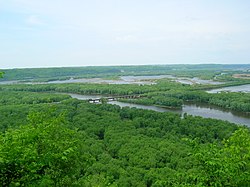Water use and abuse, here and there
Props to Ron Seely for a comprehensive look at Wisconsin water problems:
And there are related national and international contexts to Wisconsin's water struggles which now, regrettably.includes new challenges to keep the water clean.
Keep reading if you want to know why more than 160,000 acres of thirsty cotton is planted with federal subsidies where you'd least expect it - - the Arizona desert - - and also why Saudi Arabia is using Arizona desert groundwater to grow and harvest huge amounts of even thirstier alfalfa for shipment to dairy cattle operations in the parched Saudi desert.
It all underscores the wise words from the Wisconsin Supreme Court some time ago that articulates and explains water rights in our state ...

Delta at the Mississippi River, seen from Wyalusing State Park
and which also makes a good stewardship model for water use and supply management elsewhere:
Hundreds of thousands of Wisconsin’s 5.8 million residents are at risk of consuming drinking water tainted with substances including lead, nitrate, disease-causing bacteria and viruses, naturally occurring heavy metals and other contaminants, the Wisconsin Center for Investigative Journalism has found.
The problem persists, and in some areas is worsening, because of flawed agricultural practices, development patterns that damage water quality, geologic deposits of harmful chemicals, porous karst and sand landscapes, lack of regulation of the private wells serving an estimated 1.7 million people, and breakdowns in state and federal systems intended to safeguard water quality.That's why I am always happy to publicize the growing number of David v.Goliath battles in the state where local residents are using their own resources to preserve water and guarantee its unfettered access - - a public resource in Wisconsin by tradition, common sense, law and state Constitutional language and interpretation.
And there are related national and international contexts to Wisconsin's water struggles which now, regrettably.includes new challenges to keep the water clean.
Keep reading if you want to know why more than 160,000 acres of thirsty cotton is planted with federal subsidies where you'd least expect it - - the Arizona desert - - and also why Saudi Arabia is using Arizona desert groundwater to grow and harvest huge amounts of even thirstier alfalfa for shipment to dairy cattle operations in the parched Saudi desert.
It all underscores the wise words from the Wisconsin Supreme Court some time ago that articulates and explains water rights in our state ...

and which also makes a good stewardship model for water use and supply management elsewhere:
The court has ruled that DNR [Department of Natural Resources] staff, when they review projects that could impact Wisconsin lakes and rivers, must consider the cumulative impacts of individual projects in their decisions.
"A little fill here and there may seem to be nothing to become excited about. But one fill, though comparatively inconsequential, may lead to another, and another, and before long a great body may be eaten away until it may no longer exist. Our navigable waters are a precious natural heritage, once gone, they disappear forever," wrote the Wisconsin State Supreme Court justices in their opinion resolving Hixon v. PSC.(2)
Sources: (1) Quick, John. 1994. The Public Trust Doctrine in Wisconsin. Wisconsin Environmental Law Journal, Vol. 1, No. 1. (2) "Champions of the Public Trust, A History of Water Use in Wisconsin" study guide. 1995. Wisconsin Department of Natural Resources Bureau of Water Regulation and Zoning. Champions of the Public Trust [PDF].









1 comment:
Sometimes I see these posts and I think "give it up already. Nobody cares." I learned a long time ago that people really only care about the water that impacts them. Their well water. Their stream. Their lake. I know you mean well but people don't care about the statewide implications of water degradation. Look at the citizens groups. They form around one CAFO or one lake. They literally do not care what is upstream. They are unable to unite behind the real issue of writing laws that protect all of our water. They can't even articulate the need to protect basic public health for all of our citizens.
Post a Comment